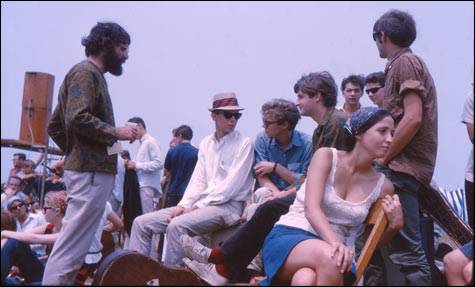
NEWPORT 1965: Joe (in the hat) with Eric Von Schmidt, Tom Rush, Geoff Muldaur, and Maria (Muldaur) d’Amato the year Joe plugged in Dylan’s guitar. |
When I first met Joe Boyd, I knew him only as a legend, the force behind the psychedelic and folk-rock movements of the 1960s. I knew he had waded into the new scene, producing records for Billy Bragg and REM, but that didn’t explain his interest in an unknown North Carolina all-girl punk-folk-pop trio called blackgirls, my band.
I still don’t know how Joe found us. He just walked into our little den of punk-rock obscurity in a white linen suit. He was inscrutable, sitting on the floor of my almost empty apartment while we played our songs live because we didn’t have a demo tape to give him. It was as if Otto Preminger had wandered onto the set of a student film shoot.
The blackgirls were considered unpredictable, weird, and confrontational. On stage it seemed as if we could implode at any minute. Our guitar player, who wore tiny mini-skirts without any underwear and flashed the audience at intervals, considered self-mutilation a viable alternative to stage patter. I sulked behind my hair and cried dark things into the microphone.
For all our mouthy, modern defiance, Joe’s presence had a retrogressive effect on us. He was The Producer, and we became a girl group. We hid drug and drink problems from him. When our guitar player overdosed during mixing, we revived her, then hid her under the pool table at the studio and told Joe she had “allergies.” After reading his memoir White Bicycles: Making Music in the 1960s (Serpent’s Tail), I think now he would have understood, but at the time he seemed so grown up, and at 25 I was both scared and starstruck.
White Bicycles delivers an eyewitness report of the psychedelic era as dapper and self-assured as Joe himself. (He’ll reminisce at Club Passim April 4, where I’ll be joining him on stage along with the Silverleaf Gospel Singers.) Whoever doubted such a coherent account was possible is unacquainted with the kind of man who can both prep at Pomfret and plug in Dylan’s guitar at Newport in 1965, delivering a convulsive dose of electroshock therapy to American folk music. Although he admits he indulged moderately in drugs, perhaps it was this combination of the patrician and the puritanical that kept Joe from going off the rails when everyone around him was tweaking madly. But in his autobiography Joe is a believer in the redemptive might of music at a crucial cultural and political juncture. He quotes Plato by way of Ginsberg to describe the revolutionary potential of music in 1967: “when the mode of the music changes, the walls of the city shake.”
There was a time when a record producer was akin to a movie director. Material, artists, and artistic choices all funneled through the vision of the man (and it was always a man) behind the board. That’s old school. But Joe Boyd is old school. Mention his name and you invoke the era of the auteur producer, also his mind-boggling association with a who’s who: Pink Floyd, Eric Clapton, Nick Drake, Sandy Denny, the Incredible String Band, Fairport Convention, Steve Winwood, Richard and Linda Thompson, and more.